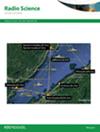2-Bit programmable metasurface for low radar cross section antenna and beam steering applications
IF 1.6
4区 地球科学
Q3 ASTRONOMY & ASTROPHYSICS
引用次数: 0
Abstract
In this paper, a 2-bit water-based programmable digital metasurface for beam steering and backscatter field reduction applications is presented, a reflective and transmissive type water based programmable metasurface (WPMS) for RCS reduction and the antenna's beam steering is suggested, respectively. It has been demonstrated that a 2-bit water-based programmable unit cell can reduce RCS by changing its state (0/1). If the unit cell channel is empty, the state is "0," if the channel is filled, the state is "1." So at different resonance frequencies, the four phase and reflection coefficient responses are achieved as "00"01"10"11". This functionality enables beam steering in both the elevation and azimuth axis and also backscattering reduction of the antenna. Furthermore, the impacts of the number of unit cells and reflection phase states on the far-field pattern are examined. Beam steering of ±45° in the elevation is attained with 10-dB impedance bandwidth of 4.25–4.40 GHz, radiation gain of more than 7.1 dBi is maintained. With the present antenna, it is possible to achieve volumetric beamsteering performance directly. The patterns of far-field radiation that are predicted theoretically coincide well with full waves simulations. As such, the proposed prototype can be a good option for applications that require a low RCS platform including beam steering in radars, 5G/6G, etc.用于低雷达截面天线和波束转向应用的 2 位可编程元表面
本文提出了一种用于波束控制和后向散射场抑制的2位水基可编程数字超表面,并提出了一种用于RCS抑制和天线波束控制的反射型和透射型水基可编程超表面。已经证明,2位水基可编程单元可以通过改变其状态(0/1)来降低RCS。如果单元格通道为空,则状态为“0”,如果通道已满,则状态为“1”。因此在不同的谐振频率下,得到4个相位和反射系数响应为“00”“01”“10”“11”。该功能使波束在仰角轴和方位轴上都可以控制,也可以减少天线的后向散射。此外,还研究了单元胞数和反射相态对远场图的影响。在4.25-4.40 GHz的10-dB阻抗带宽下,波束在仰角方向可达到±45°,辐射增益保持在7.1 dBi以上。利用现有的天线,可以直接实现体积波束控制性能。理论上预测的远场辐射模式与全波模拟吻合得很好。因此,对于需要低RCS平台的应用,包括雷达中的波束转向、5G/6G等,所提出的原型可以是一个很好的选择。
本文章由计算机程序翻译,如有差异,请以英文原文为准。
求助全文
约1分钟内获得全文
求助全文
来源期刊

Radio Science
工程技术-地球化学与地球物理
CiteScore
3.30
自引率
12.50%
发文量
112
审稿时长
1 months
期刊介绍:
Radio Science (RDS) publishes original scientific contributions on radio-frequency electromagnetic-propagation and its applications. Contributions covering measurement, modelling, prediction and forecasting techniques pertinent to fields and waves - including antennas, signals and systems, the terrestrial and space environment and radio propagation problems in radio astronomy - are welcome. Contributions may address propagation through, interaction with, and remote sensing of structures, geophysical media, plasmas, and materials, as well as the application of radio frequency electromagnetic techniques to remote sensing of the Earth and other bodies in the solar system.
 求助内容:
求助内容: 应助结果提醒方式:
应助结果提醒方式:


